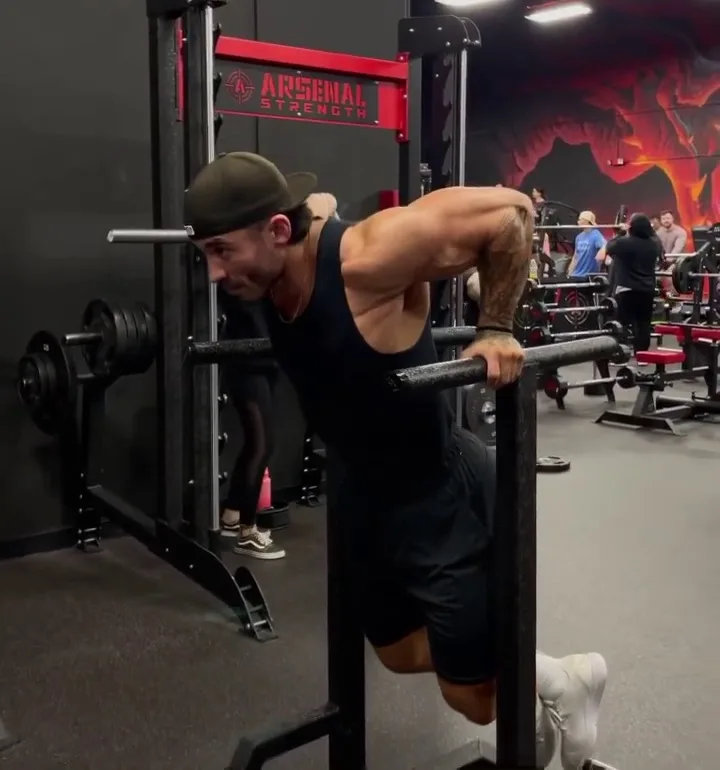The dips is a great bodyweight exercise and a good substitute for the bench press if it can’t be done for some reason, and is far superior to the decline bench press, which there’s no good reason to do.
The parallel-bar dip is a movement borrowed from gymnastics. This involves lifting yourself between and above two parallel bars, supporting yourself with your arms, lowering your body, and then driving it back up.
If “lower pecs” and triceps are your object of desire – the apple of your eye, as it were – then dips are your exercise. They’re better than declines because, like any good exercise, they engage the movement of a lot of your muscles, in addition to the lower pecs and triceps. 1 2 3 4
In this case, dips involve the movement of your entire body; They’re like push-ups in this regard. They are superior to push-ups because they can be weighted—and thus increased in weight—and performed alone, whereas push-ups simply cannot be weighted even with two people involved.
The quality of the exercise increases with the involvement of more muscles, more joints, and the central nervous system activity needed to control them. The more the body is involved in an exercise, the more likely the criteria are met. 5 6
When the whole body moves, a more nearly ideal state is achieved, in which lots of muscles and nerves control lots of joints, and the central nervous system monitors lots of different parts of the body, hopefully that is doing many different things correctly.
By this logic, push-ups are superior to bench presses, because push-ups involve full body range of motion and control. But due to the problems with loading the human body in this position, it is very difficult to do weights alone. If this were possible, a good weighted push-up device would be in use today.
For a long time it was assumed that the bench press solved that problem, when in fact it has not. The only thing moving in the bench press is the arms, so in this particular way the bench is to the push-up what the lat pull-down is to the pull-up. But the bench allows for the same approximate loading speed, and allows many people to increase their push-up numbers without the high-rep push-ups.
Without increasing the weight, a fit individual will find it difficult to train a pressing motion moving in an anterior direction without using very high reps, which are rarely appropriate for most training goals. 7
What is dips?

Dips are an upper body exercise that targets the muscles of the chest, triceps, and shoulders. To perform dips, you will need access to parallel bars or a dip station. You will start by grasping the bars with your palms facing down and your arms fully extended. You will then lower your body down towards the ground, bending your elbows and allowing your body to dip below the level of the bars. To complete a repetition, you will push back up to the starting position, straightening your arms and returning to the fully extended position.
Dips can be a challenging exercise for beginners, as they require a significant amount of upper body strength. However, they are an effective way to build muscle and improve upper body strength, and can be incorporated into a variety of workouts.
How to do dips?
Dips can be done with both—unweighted for higher reps or weighted, allowing heavier weights to be used while moving the entire body during an upper-body exercise.
Unweighted dips are harder than push-ups because the whole body is moving, not just the part that isn’t supported by the legs. For the more advanced trainee, dips are much easier to use weighted, either by hanging plates or other objects from a belt or by holding a dumbbell between the legs (an option that only works well for lighter weights). The anterior aspect of movement is provided by a slightly inclined torso position, a function of the fact that the forearms remain vertical throughout the movement.
If the mass of the body is to be distributed evenly relative to the position of the hands on the bars – i.e., half of the mass in front of the hands and half behind the hands – then the body must assume an inclined position during the movement.
There’s enough of an angle to provide a tremendous amount of pec involvement, primarily using the lower portion of the muscular abdomen. And since the arms are working downward relative to the upper body, the lats are also involved in engaging the humerus, adding even more muscle to the exercise.
Heavy weights can be used in this exercise, and many powerlifters have used it to maintain bench strength while an injury heals, one that the bench wears down, but it does not.
Dips can be used with no weight for high reps or loaded, just as the bench would be trained as a progressively loaded lift. The effect is more felt throughout the body as the weight increases, with very heavy efforts producing fatigue throughout the torso and arms.
Dips are best done on a set of dip bars, a station designed for the purpose; Most modern gyms do not have a set of parallel bars as might be found in a gymnastics studio or, previously, most gyms.
1. Instructions
To perform dips, you will need access to parallel bars or a dip station. Here’s how to do dips:
- Stand facing the dip station and grip the bars with your palms facing down.
- Walk your feet forward and straighten your arms, lifting your body off the ground so that you are supported by the bars.
- Take a deep breath and hold it; Slowly lower your body down towards the ground, bending your elbows and allowing your body to dip below the level of the bars.
- Push back up to the starting position, straightening your arms and returning to the fully extended position, and exhale at the top after you finish the rep.
- Repeat the motion for the desired number of repetitions.
- It’s important to keep your body straight and your core engaged while performing dips.
- If you are unable to lower your body all the way down, you can bend your knees and cross your ankles behind you to take some of the weight off your arms.
- As you progress and get stronger, you can try straightening your legs to increase the difficulty of the exercise.
2. Tips
1. Keep your body straight
It’s important to keep your body straight and your core engaged while performing dips. This will help you to better target the muscles of your chest, triceps, and shoulders.
2. Use a full range of motion
To fully engage the muscles you are targeting, it’s essential to use a full range of motion when performing dips. This means lowering your body all the way down until your upper arms are parallel to the ground, and then pushing back up to the fully extended position.
3. Keep your elbows close to your body
To target the triceps more effectively, try to keep your elbows close to your body while performing dips.
4. The grip
- Use a narrow grip: A narrow grip on the dip bars will place more emphasis on the triceps muscles.
- Use a wide grip: A wide grip on the dip bars will place more emphasis on the chest muscles.
- Vary your grip: You can vary your grip on the dip bars to target different muscle groups and add variety to your workouts.
- For example, you can try gripping the bars with your palms facing inward (a “neutral” grip) to target the triceps more effectively; or you can try gripping the bars with your palms facing outward (a “wide” grip) to target the chest more effectively.
- Exhale at the top: Exhale at the top after you finish the rep, and when you need the breath, be sure to take it only when you’re closed at the top. Don’t exhale during the rep; The pressure provides rib cage support that is critical for effective control of the body as it moves.
3. Dips common mistakes
Here are a few common mistakes people make when performing dips:
1. Bending at the waist
It’s important to keep your body straight and your core engaged while performing dips. If you bend at the waist, you will shift the focus of the exercise away from your upper body and onto your lower back.
2. Locking out your arms
While it’s essential to fully extend your arms at the top of the movement, it’s also important to avoid locking out your elbows. Locking out your elbows can put unnecessary strain on the joint and may increase your risk of injury.
3. Going too deep
While it’s essential to use a full range of motion, you don’t want to go too deep on your dips. Lowering your body too far can put unnecessary strain on your shoulder joint and may increase your risk of injury.
4. Not using enough resistance
If you’re not using enough resistance, you may not be challenging your muscles enough to promote strength and muscle growth. Make sure you’re using enough resistance to challenge yourself, but not so much that you’re unable to complete the exercise with good form.
5. Not using proper form
It’s essential to use proper form when performing dips to avoid injury and ensure that you are targeting the correct muscles. Make sure you are using a full range of motion and keeping your body straight and your core engaged. If you are having trouble with your form, consider seeking guidance from a personal trainer or exercise professional.
Bottom line
The dips are an effective upper body exercise that can help to build muscle and improve upper body strength. They target the muscles of the chest, triceps, and shoulders, and can be incorporated into a variety of workouts.
Dip-station bars are typically 24–26 inches wide, and the most comfortable are made from 1 1/4 or 1 1/2-inch pipe or bar stock. They are between 48 and 54-inches high, which is high enough to allow the feet to completely clear the ground at the bottom of the dip.
They need to be really, really stable, either attached to a wall or built with enough base that any possible amount of wobble during movement won’t tip the bars.
A non-parallel station, with the bars at a 30-degree angle, allows for a variety of grip widths that can more closely approximate the press, bench press or jerk grip without adversely affecting neutral hand orientation. But in a pinch (or motel room), two chairs can serve as a dip station if they’re stable when turned back to back.
To get the most out of your dips, it’s important to use proper form, challenge yourself with appropriate resistance, and vary your grip to target different muscle groups. If you are new to dips or have any concerns about your form or technique, consider seeking guidance from a personal trainer or exercise professional.
- Kovar E. 6 triceps brachii exercises for stronger triceps. American Council on Exercise.[↩]
- American Council on Exercise. Follow-up Q and A: Dangerous Dips.[↩]
- Amritashish Bagchi. “A comparative electromyographical investigation of triceps brachii and pectoralis major during four different freehand exercises.” J Phys Educ Res. 2015;2(II):20-27.[↩]
- Alec McKenzie, Zachary Crowley-McHattanORCID, Rudi Meir, John Whitting and Wynand Volschenk. “.” Int. J. Environ. Res. Public Health 2022, 19(20), 13211; doi: 10.3390/ijerph192013211.[↩]
- Julie A Morgan, Frances Corrigan, and Bernhard T Baune. “Effects of physical exercise on central nervous system functions: a review of brain region specific adaptations.” J Mol Psychiatry. 2015; 3: 3. doi: 10.1186/s40303-015-0010-8. PMCID: PMC4461979. PMID: 26064521.[↩]
- Australia’s physical activity and sedentary behaviour guidelines, Department of Health and Ageing, Australian Government.[↩]
- Sources: Starting Strength: Basic Barbell Training, By Mark Rippetoe. Available here: https://amzn.to/3vD9K8K.[↩]















